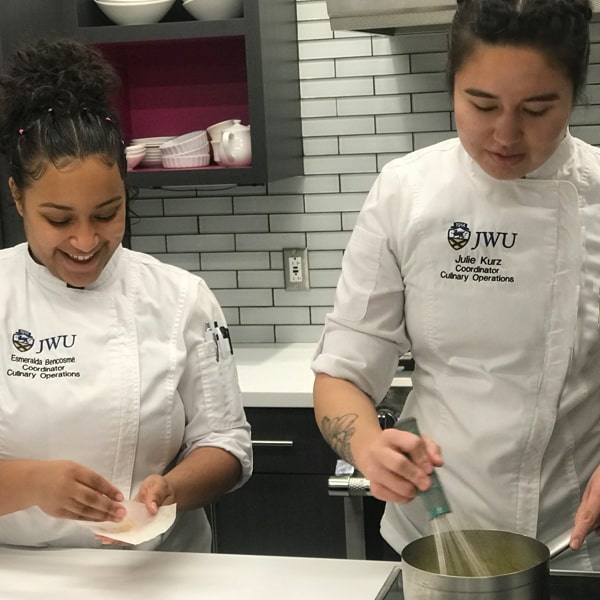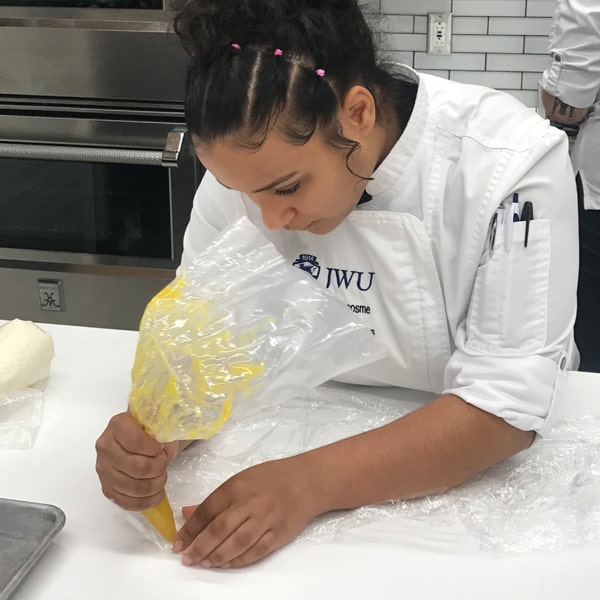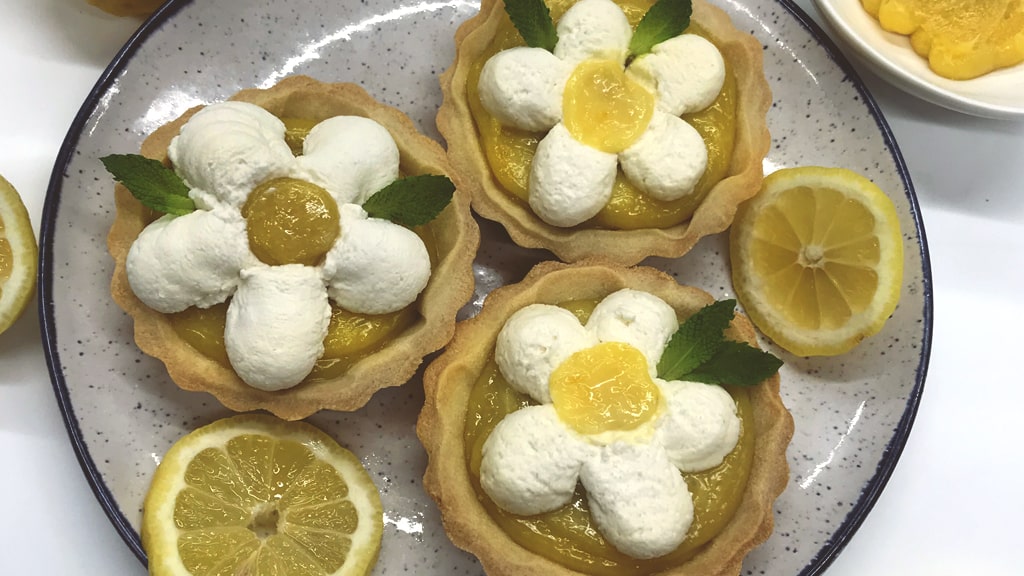JWU Recipes: Springtime Lemon Curd
When life gives you lemons, why not make lemon curd? It’s a versatile and delicious addition to brunch (it adds zip and sophistication to pancakes and French toast, for example). It’s fantastic as a cupcake filling. You can also use it to make a beautiful spring tartlet, which we will do today. (We recommend buying a high-quality par-baked tartlet shell or shells and filling them with your freshly-made curd.)
It can be a bit tricky to make, though. Why is that? Well, adding egg yolks means you must be careful not to curdle them. While the recipe only has four ingredients and takes roughly 30 minutes, you need to stay focused. On the plus side, the limited ingredients are all pantry staples, so this is an inexpensive and versatile addition to your cooking arsenal!
“You can use this curd for a variety of different desserts.”
Culinary operations coordinators Julie Kurz '21, '23 MBA and Esmeralda Bencosme '22, '24 MBA will take us through each step. They add the egg yolks, sugar and lemon juice to a heavy-bottomed pot on low heat. Start whisking, then slowly begin to incorporate the cubed butter. “Add butter cubes into the mixture gradually, ensuring every piece of butter is fully incorporated before adding more,” says Bencosme. Then whisk, whisk, and whisk some more! (This recipe is a great wrist workout.)
 How do you know when the curd is done?
How do you know when the curd is done?
“When you’re stirring, and the color is light — and it’s still liquid-y — it’s not done,” says Kurz. “You want to get it to a point where you can draw a line in it, and it stays. By this point, it will also darken and get deep yellow in color.”
“You can use this curd for a variety of different desserts,” explains Bencosme. “Today, we made tartlets. To do that, take the curd while still warm and pour it into the tartlet shells.”
When pouring the curd into your pre-baked pastry shell, “tap the shell on the counter to get the curd to settle. This will also remove air bubbles!” notes Bencosme. You’ll want to place the tartlet(s) in the fridge for 2-3 hours to set properly before serving.
To finish, explains Bencosme, “Decorate with either a stiff peak meringue or whipped cream. Today we decorated the tartlets with a pastry tip and added a dot of lemon curd in the middle to resemble a spring flower.” You can add mint sprigs as well.
 Tips & Tricks
Tips & Tricks
🍋 Buy organic lemons. (Non-organic lemons are usually waxed.) Let your lemons come to room temperature before juicing.
🍋 Want to make sure your lemon will release all of its juice? Roll it on your counter firmly before juicing it — getting all that delicious juice will be easier.
🍋 Want to boost the lemon flavor of your curd? Use a microplane to zest roughly two tablespoons of lemon rind. Place the zest in a bowl with your sugar; use your fingers to rub the two ingredients together, releasing the fragrant citrus oils. Then add them to the curd mixture as noted in the recipe below.
🍋 The lemon curd is built on whisking! Whisk, whisk, whisk. This is the trick to get it to properly thicken. As you are whisking, you need to keep an eye on the heat and ensure it’s kept low to not push the yolks to curdle. (This is more of a problem if you have a gas stove, where the heat can fluctuate more readily.)
🍋 What differentiates lemon curd from lemon custard? Lemon custard typically includes whole eggs in addition to yolks and might incorporate whole milk or heavy cream; it’s generally thickened with gelatin or cornstarch.
Tips for a Vegan Variation
- For thickening, use cornstarch.
- If you are omitting egg yolks, you will need something to add the fattiness and rich mouthfeel. Most vegan recipes recommend light coconut milk (as opposed to full-fat versions) because it will add richness without tasting overpoweringly of coconut.
- Substitute a high-quality vegan butter, cubed.
- For a color boost, add half a teaspoon of ground turmeric. (It’s a small enough amount that it won’t change the flavor perceptibly.)
WATCH THE RECIPE VIDEO BELOW:
View this post on Instagram
RECIPE: SPRINGTIME LEMON CURD
INGREDIENTS
4 egg yolks
½ cup of granulated sugar
½ cup of fresh lemon juice
5 tablespoons of unsalted butter
Zest from one lemon
DIRECTIONS
- Place the egg yolks, sugar, and lemon juice in a small pot. Whisk to combine, then turn on very low to low heat.
- Whisk for roughly 3 to 5 minutes or until the liquid starts thickening.
- Cut the butter into small cubes and slowly add them to the pot. Whisk until melted and combined each time before adding more.
- Add the lemon zest.
- Cook on low heat for 5 to 15 minutes or until the curd has thickened. Continuously whisk to avoid lumps.
- To check if the curd is cooked, dip the back of a spoon into the curd, then draw a line in the curd with your fingers.
- While still warm, pour the curd into the tartlet shells. Gently tap each tartlet against a hard surface to remove any air bubbles, then place it in the fridge to set for at least 2 to 3 hours.
RELATED READING
A Is for Apple (Pie)
Heart-Shaped Ravioli
TOP: THE FINISHED TARTLETS. BELOW: JULIE KURZ (LEFT) AND ESMERALDA BENCOSME (RIGHT) POSE AFTER MAKING THE LEMON CURD.





